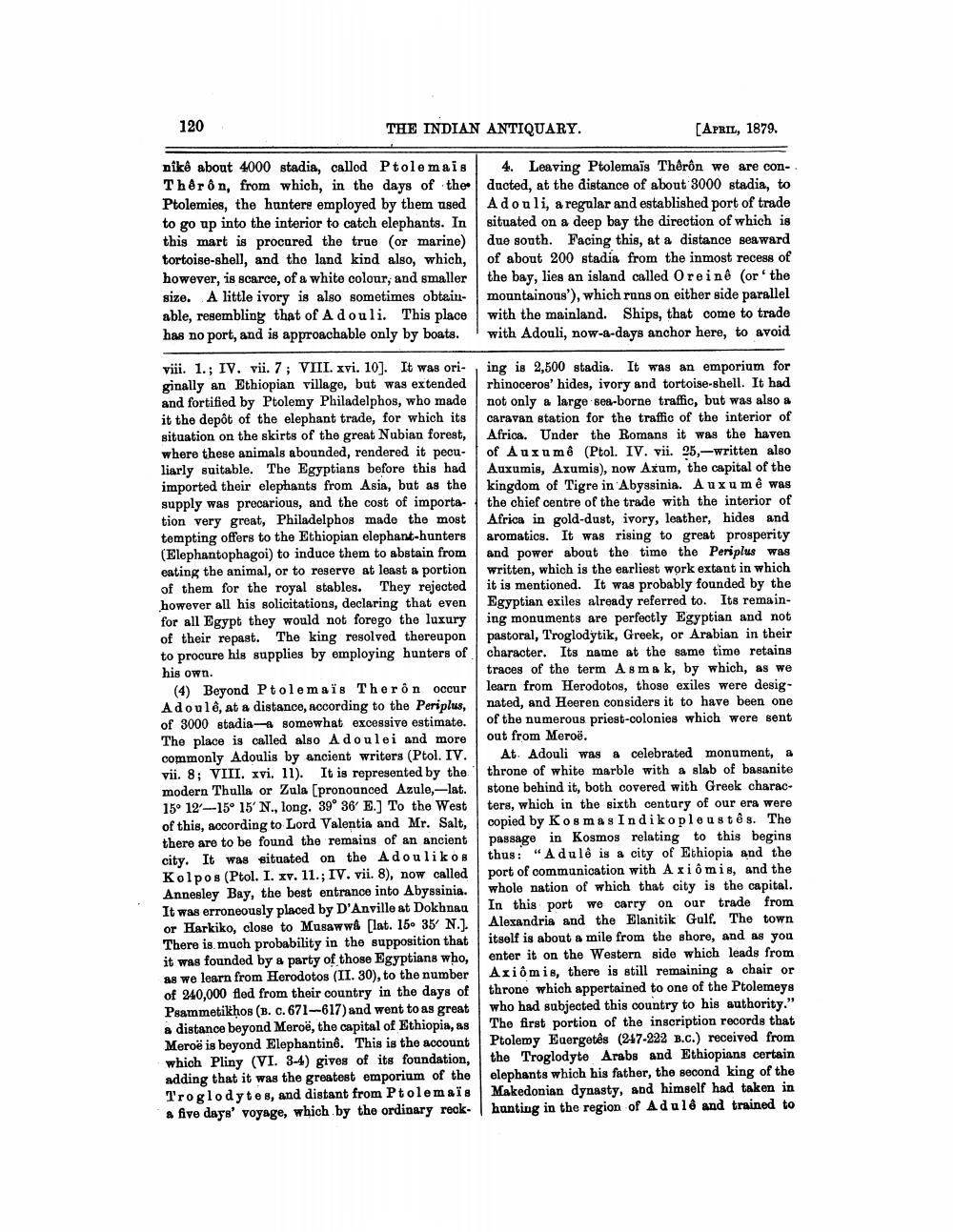________________
120
THE INDIAN ANTIQUARY.
nîkê about 4000 stadia, called Ptolemais Thêrôn, from which, in the days of the Ptolemies, the hunters employed by them used to go up into the interior to catch elephants. In this mart is procured the true (or marine) tortoise-shell, and the land kind also, which, however, is scarce, of a white colour, and smaller size. A little ivory is also sometimes obtain able, resembling that of A douli. This place has no port, and is approachable only by boats.
viii. 1.; IV. vii. 7; VIII. xvi. 10]. It was originally an Ethiopian village, but was extended and fortified by Ptolemy Philadelphos, who made it the depôt of the elephant trade, for which its situation on the skirts of the great Nubian forest, where these animals abounded, rendered it peculiarly suitable. The Egyptians before this had imported their elephants from Asia, but as the supply was precarious, and the cost of importation very great, Philadelphos made the most tempting offers to the Ethiopian elephant-hunters (Elephantophagoi) to induce them to abstain from eating the animal, or to reserve at least a portion of them for the royal stables. They rejected however all his solicitations, declaring that even for all Egypt they would not forego the luxury of their repast. The king resolved thereupon to procure his supplies by employing hunters of
his own.
(4) Beyond Ptolemais Theron occur Adoule, at a distance, according to the Periplus, of 3000 stadia-a somewhat excessive estimate. The place is called also Ado ulei and more commonly Adoulis by ancient writers (Ptol. IV. vii. 8; VIII. xvi. 11). It is represented by the modern Thulla or Zula [pronounced Azule,-lat. 15° 12-15° 15' N., long. 39° 36′ E.] To the West of this, according to Lord Valentia and Mr. Salt, there are to be found the remains of an ancient city. It was situated on the Adoulikos Kolpos (Ptol. I. xv. 11.; IV. vii. 8), now called Annesley Bay, the best entrance into Abyssinia. It was erroneously placed by D'Anville at Dokhnau or Harkiko, close to Musawwa [lat. 15° 35' N.] There is much probability in the supposition that it was founded by a party of those Egyptians who, as we learn from Herodotos (II. 30), to the number of 240,000 fled from their country in the days of Psammetikhos (B. c. 671-617) and went to as great a distance beyond Meroë, the capital of Ethiopia, as Meroë is beyond Elephantinê. This is the account which Pliny (VI. 3-4) gives of its foundation, adding that it was the greatest emporium of the Troglodytes, and distant from Ptolemaïs a five days' voyage, which by the ordinary reck
[APRIL, 1879.
4. Leaving Ptolemaïs Thêrôn we are conducted, at the distance of about 3000 stadia, to Adouli, a regular and established port of trade situated on a deep bay the direction of which is due south. Facing this, at a distance seaward of about 200 stadia from the inmost recess of the bay, lies an island called Oreinê (or' the mountainous'), which runs on either side parallel with the mainland. Ships, that come to trade with Adouli, now-a-days anchor here, to avoid
ing is 2,500 stadia. It was an emporium for rhinoceros' hides, ivory and tortoise-shell. It had not only a large sea-borne traffic, but was also a caravan station for the traffic of the interior of Africa. Under the Romans it was the haven of Auxumê (Ptol. IV. vii. 25,-written also Auxumis, Axumis), now Axum, the capital of the kingdom of Tigre in Abyssinia. Auxumê was the chief centre of the trade with the interior of Africa in gold-dust, ivory, leather, hides and aromatics. It was rising to great prosperity and power about the time the Periplus was written, which is the earliest work extant in which it is mentioned. It was probably founded by the Egyptian exiles already referred to. Its remaining monuments are perfectly Egyptian and not pastoral, Troglodytik, Greek, or Arabian in their character. Its name at the same time retains traces of the term Asmak, by which, as we learn from Herodotos, those exiles were designated, and Heeren considers it to have been one of the numerous priest-colonies which were sent out from Meroë.
At. Adouli was a celebrated monument, a throne of white marble with a slab of basanite stone behind it, both covered with Greek characters, which in the sixth century of our era were copied by Kosmas Indikople ustês. The passage in Kosmos relating to this begins thus: "Adulê is a city of Ethiopia and the port of communication with A xiômis, and the whole nation of which that city is the capital. In this port we carry on our trade from Alexandria and the Elanitik Gulf. The town itself is about a mile from the shore, and as you enter it on the Western side which leads from Axiômis, there is still remaining a chair or throne which appertained to one of the Ptolemeys who had subjected this country to his authority." The first portion of the inscription records that Ptolemy Euergetês (247-222 B.C.) received from the Troglodyte Arabs and Ethiopians certain elephants which his father, the second king of the Makedonian dynasty, and himself had taken in hunting in the region of Adulê and trained to




